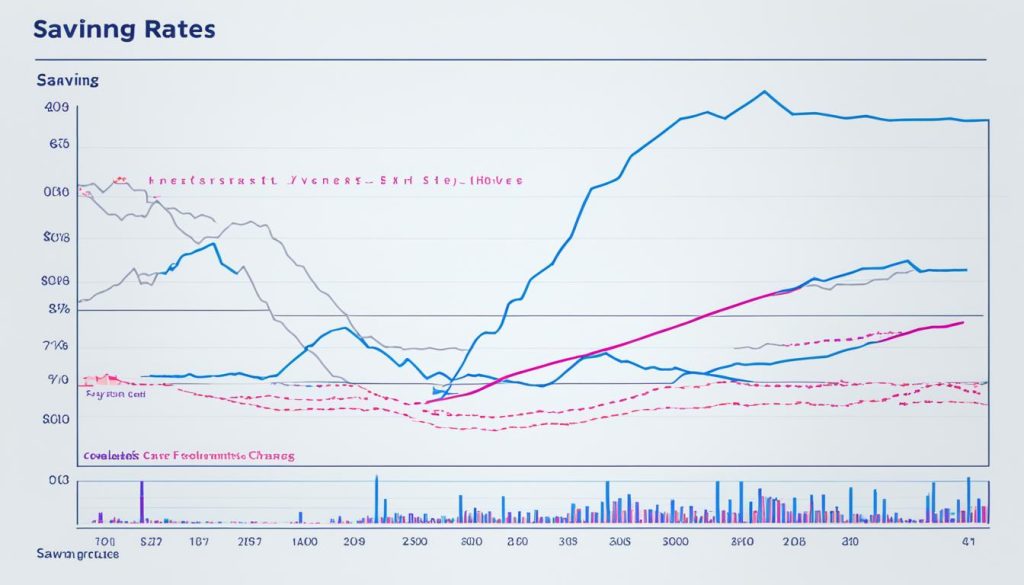The Federal Reserve is the central bank of the United States. It plays a big role in the economy, including your investment strategy. Its decisions on1 interest rates and bond purchases affect borrowing costs and savings. These actions also impact the stock market and the economy’s health.
It’s important for investors to understand how the Federal Reserve works. Knowing this helps you grow your money and adjust your investment plans. This knowledge is key for making smart financial choices.
Key Takeaways
- The Federal Reserve’s monetary policy decisions can significantly impact your borrowing costs and savings yields.
- Changes in interest rates can affect the performance of the stock market and overall economic growth.
- Monitoring the Federal Reserve’s actions is essential for investors to make informed decisions and adjust their investment strategies accordingly.
- Understanding the Federal Reserve’s mandate and its role in the economy can help you navigate the financial landscape more effectively.
- Staying informed about the Federal Reserve’s influence on various aspects of the economy can help you better manage your personal finances and investment portfolio.
What is the Federal Reserve and Its Role?
The Federal Reserve, known as the Fed, is the central bank of the United States2. It sets policies to keep prices stable and employment high2. The Fed uses tools like changing interest rates to control credit availability and cost2. This helps keep inflation low and supports economic growth, affecting investors and their plans.
Understanding the Central Bank’s Mandate
The Federal Reserve aims for stable prices and full employment2. It watches economic signs like inflation, job rates, and growth3. The FOMC, made up of the Board and regional Bank presidents, meets often to decide on policies23.
The Fed’s main tool is the federal funds rate, the rate banks lend to each other overnight3. Changing this rate affects borrowing costs for businesses and people3. This can change inflation, jobs, and the economy, important for investors to know.
Knowing the Federal Reserve’s role and its economic impact is key for investors23.
How the Fed’s Interest Rate Decisions Affect Your Borrowing Costs
The federal reserve‘s interest rate decisions affect how much it costs to borrow money. When the Fed raises interest rates, it makes borrowing money more expensive. This includes things like mortgages, loans, credit cards, and auto loans. It also affects consumer finance4. This can lead to people spending less and investing less, which can slow down the economy. On the other hand, when the Fed lowers interest rates, borrowing money gets cheaper. This can help boost the economy4.
In March 2020, the Federal Reserve cut its target interest rate by 1.5 percentage points. This made borrowing money cheaper for both people and businesses4. But in December 2021, the Fed said it plans to raise interest rates in 2022. This means borrowing costs will likely go up soon.
Mortgage rates also change because of the Federal Reserve. Usually, there’s a 1.5 to 2 percentage point gap between the 10-year Treasury yield and fixed-rate mortgages. But this gap grew to 3 percentage points in 2023 and 2024 as the Fed raised rates to fight inflation5. Adjustable-rate mortgages (ARMs) change with the Fed’s key interest rate. This is because they’re tied to the Secured Overnight Financing Rate (SOFR)5.
The Federal Reserve’s interest rate decisions are key to understanding borrowing costs. They work together with your own financial situation to shape your borrowing costs. Knowing this helps you make better financial choices and manage your money well.
The Impact on Your Savings and Investment Accounts
The Federal Reserve’s interest rate decisions affect your savings and investment accounts a lot6. When rates go up, banks raise the interest on savings accounts and CDs, giving you a chance to earn more6. But when rates drop, these interests might fall, making it harder to make money from your savings7.
Capitalizing on Higher Yields
Knowing the Fed’s rate cycle helps investors make the most of their savings and investments6. For example, high-yield savings accounts at SoFi, EverBank, and Barclays offer APYs from 4.60% to 5.05%6. Wealthfront Cash Account gives a 5.00% APY with just $1 needed6. And Betterment Cash Reserve offers 5.50% APY with special deals6.
Marcus by Goldman Sachs High-Yield CD has a 4.85% APY for 6 months, and Bask Bank CD offers 5.00% APY for 9 months6. But, accounts like Discover® Cashback Debit and Chase Total Checking® don’t offer APYs6. The Discover® Money Market Account gives a 4.00% APY with no minimum balance6.
The average savings account rate is 0.46% nationally, but online accounts often have much higher rates because they’re cheaper to run7.

“When the Fed increases rates, savings account APYs like high-yield savings accounts or CDs also rise, making saving more appealing.”7
Keep up with the Federal Reserve’s rates and check the yields on different accounts to make the most of your money678.
Federal Reserve and the Stock Market
The federal reserve‘s decisions can greatly affect the stock market and your equity investments. When the Fed raises interest rates, the stock market can become more unstable. This happens as investors change their plans and strategies. Higher rates make borrowing costlier for, which might lower their profits and stock prices9.
On the other hand, when the Fed cuts rates, stocks might do better. Cheaper credit and more money flowing around can help companies earn more and boost investor confidence. It’s important for investors to watch the Fed’s moves closely. This helps them manage risk and improve their portfolio performance.
| Metric | 2022 | 2023 | 2024 |
|---|---|---|---|
| S&P 500 Gains | -18.1% | 7.6% | 8.2%10 |
| Federal Funds Rate | 0.25% – 0.50% | 4.25% – 4.50% | 5.25% – 5.50%10 |
| 10-Year Treasury Yield | 3.88% | 4.20% | 4.70%10 |
The table shows how the federal reserve‘s interest rate hikes affect the stock market and bond yields. As the Fed raised rates to fight inflation, the stock market saw more ups and downs and smaller gains than before10.
“The evolving consensus among economists since the Great Depression is reflected in titles such as ‘A Monetary History of the United States’ by Milton Friedman and Anna Schwartz in 1963, cited by prominent individuals including Federal Reserve Board of Governors members like Ben Bernanke, Donald Kohn, and Frederic Mishkin.”9
Knowing the federal reserve‘s impact on the stock market helps investors make better choices. They can adjust their equity investments to handle the volatility and risk management linked to policy changes.

The Federal Reserve’s Influence on the Economy
The federal reserve is key in shaping economic growth, inflation, and employment in the U.S11.. It uses tools like interest rates and open market operations to affect spending. This, in turn, impacts the financial stability and macroeconomic analysis of the economy11.
When the economy is growing too fast, the Federal Reserve might raise interest rates to slow it down and control inflation11. On the other hand, during slow times, it can lower rates to boost consumer spending and business investment. This helps with employment and economic growth11.
The Federal Reserve’s monetary policy affects many people, businesses, and the economy11. It’s important to understand the bank’s strategies and their effects on the economy. This helps investors, policymakers, and the public make better decisions11.
“The Federal Reserve has a profound influence on the economy, with its ability to adjust interest rates and control the money supply. Its actions can significantly impact everything from consumer spending to business investment and employment levels.”
By watching the Federal Reserve, people and businesses can prepare for economic changes. They can adjust their investment strategies and financial plans accordingly11.
Conclusion: Understanding the Federal Reserve’s role and its influence on various aspects of the economy, including
The Federal Reserve plays a big role in your finances and investment plans. It aims to keep prices stable and help everyone find work12. Knowing this helps you make better choices for your money.
When the Fed changes interest rates, it changes how much you pay on loans and what you earn on savings. If rates go up, you might pay more on your mortgage and credit cards. But, you could also earn more on your savings13.
The Fed also affects the stock market. Its actions can change how people feel about investing, how much the market moves, and how well your investments do. By keeping up with the Fed, you can manage your risks better and grow your wealth12.
FAQ
What is the Federal Reserve and what is its role?
The Federal Reserve is the central bank of the United States. It sets monetary policy for price stability and maximum employment. The Fed uses tools like interest rates and open market operations to control credit availability and cost.
How do the Federal Reserve’s interest rate decisions affect my borrowing costs?
The Fed’s interest rate decisions affect your borrowing costs. Higher rates make borrowing for things like homes and cars more expensive. Lower rates make borrowing cheaper, which can boost the economy.
How do the Federal Reserve’s policies impact my savings and investment accounts?
The Fed’s interest rate policies affect your savings and investment accounts. Higher rates mean higher returns on savings accounts and CDs. Lower rates can make it harder to earn income from savings.
How does the Federal Reserve’s influence the stock market and my investment portfolio?
The Fed’s policies can impact the stock market and your investments. Higher rates can make the stock market more volatile and affect company profits. Lower rates can make stocks more attractive by making borrowing cheaper.
How does the Federal Reserve’s influence the broader economy?
The Fed’s policies affect more than just the financial markets. They can influence spending, jobs, and inflation. The Fed raises rates to slow down the economy and lower rates to boost growth and jobs.
Source Links
- 6 Ways The Fed’s Interest Rate Decisions Impact Your Money | Bankrate
- Who We Are
- Structure and Functions of the Federal Reserve System
- What did the Fed do in response to the COVID-19 crisis?
- How The Fed’s Rate Decisions Move Mortgage Rates | Bankrate
- What the Fed Rate Announcement Means for Savings Accounts – NerdWallet
- The Fed’s monetary policy can impact your savings
- Impact of Federal Reserve Interest Rate Changes
- Stock Market Crash of 1929
- How Do Changing Interest Rates Affect the Stock Market? | U.S. Bank
- The Fed’s Tools for Influencing the Economy
- What Is the Federal Reserve and How Does It Work?
- The impact of Federal Reserve policy on the Fed’s financial conditions index

